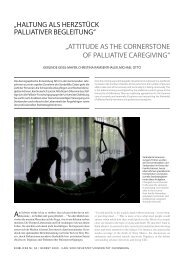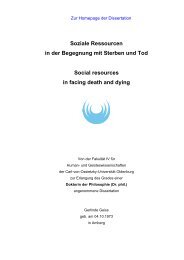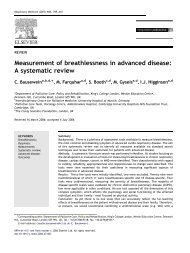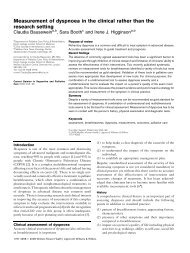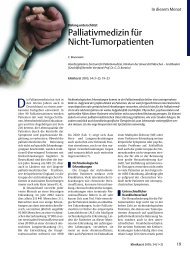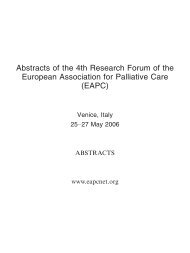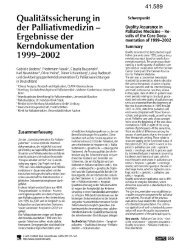EAPC - ipac
EAPC - ipac
EAPC - ipac
You also want an ePaper? Increase the reach of your titles
YUMPU automatically turns print PDFs into web optimized ePapers that Google loves.
410 <strong>EAPC</strong> Abstracts<br />
35 Oral Presentation<br />
Cachexia<br />
A novel Cachexia Classification for Palliative Cancer Care:<br />
Synthesis of systematic literature review and nominal experts’<br />
focus group<br />
Authors: Florian Strasser Dept. Internal Medicine & Palliative Care Centre<br />
Oncological Palliative Medicine, Section Oncology SWITZERLAND<br />
Aurelius Omlin Oncological Palliative Medicine, Cantonal Hospital<br />
St. Gallen SWITZERLAND<br />
Jochen Walker Oncological Palliative Medicine and Surgery, Cantonal<br />
Hospital St.Gallen SWITZERLAND<br />
David Blum Oncological Palliative Medicine, Cantonal Hospital St.Gallen<br />
SWITZERLAND<br />
Ken Fearon Surgical Oncology, Royal Infirmary of Edinburgh Edinburgh<br />
UNITED KINGDOM<br />
repesenting the EPCRC<br />
Background: The current definition of cancer cachexia (weight loss,<br />
anorexia) does poorly guide practice. To monitor clinical decisions, alleviate<br />
suffering and develop tailored anti-cachexia interventions, a novel cachexia<br />
classification system, adjusted for palliative care, is required. Methods: A<br />
SLR (1976–2007) was performed (Pubmed, Cochrane, Embase, PsycINFO,<br />
CinAhl; search strings: cachexia, cancer, classification). Inclusion criteria:<br />
system or factor to classify patients with cachexia or to predict response to<br />
anticachectic treatment. Data extraction (2 raters) applied a formalized list,<br />
considering results of the first FG. Scoring for quality (Hawker) is done.<br />
Nominal FG of 12 academic cachexia experts discussed in 2 rounds “Which<br />
factors guide clinical decision making for cachexia management in daily<br />
practice” Key findings from the first round and the SLR were presented in<br />
the second round. Collaboration with a non-cancer specific wasting/cachexia<br />
consensus group was achieved. The final synthesis includes eligibility criteria<br />
and stratification factors from registered anti-cachexia trials and applies<br />
a structured Delphi-type review process. Results: Of 9817 citations,<br />
126 papers (7 systems, 112 factors; 7913 patients [50% GI, 20% lung cancer])<br />
were included. 4 systems combined anthropometrics (AM), nutritional<br />
intake (NI), symptoms (SY) and inflammation (INF), 2 systems AM/NI and<br />
either SY or INF, 1 added REE and hormones. All systems challenge the old<br />
definition. Of the single factors, AM, INF, muscle strenght and ghrelin classify<br />
cachexia in most studies, whereas NI, SY, metabolic alterations, REE,<br />
and leptin are variably reported. Responders in 84 anticachexia trials were<br />
not identified by factors. Consensus appears in cachexia as ongoing loss of<br />
muscle mass with 3 domains: depleted muscle protein, decreased ability to<br />
eat, and a catabolic drive. Symptoms are in all domains. Conclusions: A<br />
novel, pragmatic CCS-PC hold promise for care and research.<br />
36 Invited Lecture<br />
Systematic Reviews – what they can and what they can’t do<br />
Systematic reviews: an essential tool or a fashionable foible<br />
Authors: Lukas Radbruch Department of Palliative Medicine University of<br />
Aachen GERMANY<br />
Research in palliative care faces many barriers, among them physical frailty<br />
and cognitive impairment as well as a general reluctance of clinical staff to<br />
recruit patients, as clinical trials are felt to be in contradiction with the holistic,<br />
caring philosophy of palliative care. Sample sizes of published studies<br />
are small, with wide variations in the study populations. This has led to an<br />
increasing use of systematic review in an attempt to collate high quality<br />
information from these studies. The use of systematic reviews is also fostered<br />
by the rise of evidence-based medicine (EBM), as systematic reviews<br />
are on the top of the scoring lists of EBM. Systematic reviews allow for a<br />
quick and comprehensive apprehension of the available literature.<br />
However, there are some drawbacks to the new fashion of EBM. User as<br />
well as authors of systematic reviews often forget that the absence of evidence<br />
does not equal the evidence of absent efficacy. Many reviews start<br />
high with elaborate search strategies and inclusion criteria, and end modestly<br />
with only a few papers (which could not be compared) found useful for<br />
their remit. Many reviews end with the stereotypical statement: there is not<br />
enough evidence. There is an inherent danger from this position, as it may<br />
lead decision makers to focus on those treatments only which have been<br />
proven effective with EBM. This means that decisions focus on systematic<br />
reviews and the randomized trials that generated them, and users forget that<br />
other evidence is also acknowledged in EBM, though on a lower level.<br />
Even the much maligned expert opinion is part of EBM, if no (randomized)<br />
trials are available. There may be good reasons why there are no randomized<br />
trials. For example the evidence from randomized trials on the efficacy<br />
of morphine is scarce, but running such a trial today would be unnecessary<br />
and inacceptable from an ethical point of view. We have to take care<br />
that we use systematic reviews where we need them, but not as a means to<br />
end all discussions.<br />
37 Invited Lecture<br />
Systematic Reviews – what they can and what they can’t do<br />
Cochrane reviews in palliative care: where is the evidence<br />
Common errors and problems with systematic reviews in palliative<br />
care and how to overcome<br />
Authors: Phil J. Wiffen Churchill Hospital, Pain Research Unit Pain,<br />
Palliative & Supportive Care CRG UNITED KINGDOM<br />
This lecture will present an overview of what we currently have in terms of<br />
systematic reviews and controlled trials. Current challenges include a lack<br />
of suitable data for analysis, continued use of practices that have been<br />
shown to be ineffective or have little supporting evidence, challenges of<br />
extrapolation of results from outside palliative care and imperfect methodology<br />
to get the best from qualitative data. The goal of developing a systematic<br />
review for the major issues in palliative care is not an impossible dream<br />
but will need to stimulate a higher standard of research and development of<br />
collaborative research groups that can recruit larger numbers of participants<br />
for trials.<br />
38 Invited Lecture<br />
Systematic Reviews – what they can and what they can’t do<br />
Drug treatment of cancer-related fatigue. An example of a<br />
Cochrane review and of the problems with extrapolating<br />
results from cancer to palliative care<br />
Authors: Paddy Stone Division of Mental Health St George’s Hospital<br />
Medical School UNITED KINGDOM<br />
This presentation will discuss the difficulties of using the results of a<br />
Cochrane systematic review in routine clinical practice. The presentation<br />
will be illustrated with the example of a recently conducted review and<br />
meta-analysis of randomised controlled trials for patients with cancerrelated<br />
fatigue (full results presented elsewhere). The author will explain<br />
how the review group settled on inclusion and exclusion criteria for the systematic<br />
review. These were based on a study quality standard requiring randomisation<br />
of treatment as a minimum. The impact of using different search<br />
strategies will be discussed. The chosen search strategy identified over<br />
5000 abstracts with 116 being short-listed for potential inclusion. Only<br />
45 studies fully met the inclusion criteria. It was decided only to analyse<br />
studies that used multi-item outcome measures – thus 27 trials were included<br />
in the meta-analysis. The rigorous criteria used in Cochrane reviews led<br />
to the exclusion of drug treatments examined only in phase 2 studies. Many<br />
studies of palliative care patients fell into this category and were excluded<br />
at the screening stage. The discussion of selected results will focus on how<br />
the findings can be applied in clinical practice. The populations studied<br />
were mainly receiving active treatment. The majority of the data comes<br />
from trials of anaemic cancer patients receiving erythrocyte colony growth<br />
factors such as erythropoietin. It is unclear how these results can be applied<br />
to a palliative care population without further study. The author will discuss



